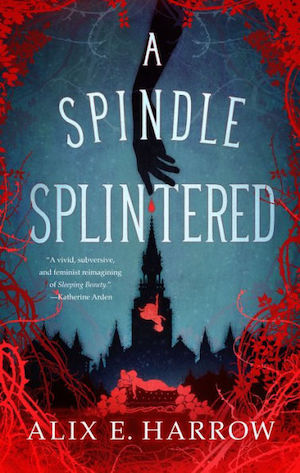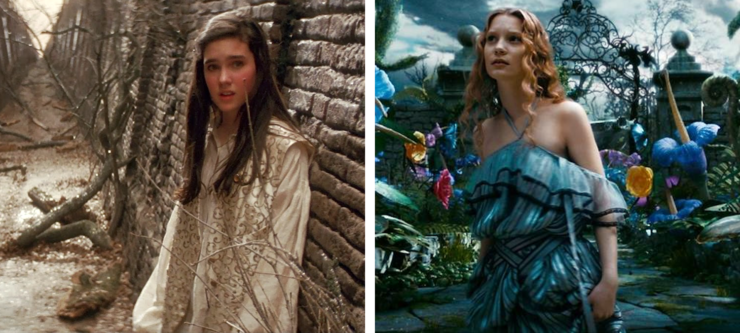Between the bullying I faced at school and a slew of family problems at home, my teenaged self found an escape in portal fantasies. At 16, I was shy, precocious, and full of fear—I’d never had a boyfriend, but I was deeply disturbed by the male attention I received on the early social media sites. Stories of girls disappearing down rabbit holes or being whisked into a fantastical underworld—populated by strange creatures and even stranger men—toppling law and order, and then triumphantly returning to real life, became favorite templates onto which I could project my fantasies and trauma.
My favorite comfort films at that time were Jim Henson’s Labyrinth (1986), a dark fantasy film featuring muppets and David Bowie as the Goblin King, and Tim Burton’s Alice in Wonderland (2010), a CGI-drenched adaptation rather loosely based on Lewis Carroll’s books, with Johnny Depp in the whimsical role of the Mad Hatter. Throughout high school, I probably rewatched those movies more times than was strictly healthy. I also read and wrote countless fanfics based on the films’ characters and fantastical lore, exploring alternate endings and relationships. But I’m 24 now, perhaps more mature but still traumatized, and the isolation brought about by the Covid-19 lockdown gave me a chance to revisit them and consider why they made such an impact on me.
Labyrinth centers on its young protagonist Sarah stranded in a maze, solving a series of logic puzzles and optical illusions, in a race against time to save her baby brother from being turned into a goblin, all the while resisting her attraction to the alluring Goblin King. Meanwhile Alice, like a typical fantasy hero, must rescue her friends, get her hands on some magical artifacts, and slay a fabulous beast to free “Underland” (which was once Wonderland) from the clutches of the autocratic Red Queen and her evil Knave. Both movies feature similar and straightforward quest-driven plots and, obliquely or otherwise, depict a young woman’s sexual awakening within a larger coming-of-age narrative about adulthood and responsibility. The films also present different versions of masculinity, with Jareth (the Goblin King) as a beguiling but ultimately toxic, controlling figure and the Mad Hatter serving as a more emotionally open, empathetic friend and ally in his relationship with the protagonist. The two opposing portrayals of male behavior also opened up for me two different ways of thinking about trauma.
Although billed as a children’s film, the heightened sexual tension between Jareth and Sarah in Labyrinth is very apparent. The toys, magazine clippings, and accessories scattered in Sarah’s bedroom suggest that the labyrinth is a figment of her imagination and that the Goblin King is based upon her absent mother’s glamorous boyfriend (glimpsed in photos and newspaper clippings taped to Sarah’s mirror; this backstory is fleshed out further in the official novelization of the movie). If that wasn’t creepy enough, Jennifer Connelly was 16 when she played the role of Sarah, while David Bowie was almost 40 when he strutted about in his leather pants opposite her as the immortal fey overlord. At one point, Sarah is distracted from her quest by a hallucinatory masquerade ball—Jareth pulls her into a romantic dance as strangers look on, amidst a background littered with phallic masks and objects.
Yet the film’s concluding message is one of empowerment and freedom. To escape the labyrinth, Sarah must not only solve it but also break the Goblin King’s thrall over her. She must turn down the lavish gifts and untold wonders he has offered as well as decline the chance to be his immortal subservient queen, finally uttering those crucial words: “You have no power over me.” To escape the terrors of the imagination, which are often informed by real fears and anxieties, Sarah must break his heart utterly and reject his control, recognizing toxicity and abuse for what it is. It reminds the viewer that mental and emotional manipulation—Jareth’s attempts to isolate, control, threaten and cajole Sarah throughout the film, the conditioning that leads up to his ultimate demand: “Just fear me, love me, do as I say and I will be your slave…”—are just as dangerous, damaging, and difficult to escape as more obvious, physical threats. Indeed, in the precarious world of the labyrinth (with its oubliettes and foul swamps), the various moments of physical danger and emotional distress Sarah endures feed upon one another in an interlocking loop of patriarchal dominance and control, mirroring in fantasy the very real, lived experiences of so many women.
The Mad Hatter from Underland, by comparison, is far more benign. He tells Alice just how much she has changed since her last visit as a child (“You’ve lost your muchness”), but also reminds her of her core values and beliefs. Their alliance is founded upon friendship and mutual regard for the other’s welfare. While the Hatter risks his life to aid Alice, she too prioritizes rescuing him. Like Jareth, he also begs her to stay and is unsettled at the idea that he has no independent existence outside her imagination, but he doesn’t make any malicious threats or false promises. Their eventual farewell is sad and poignant, but strangely peaceful—it offers closure, but with a possibility of return. While the earlier drafts of the screenplay featured a romantic angle between the two characters, the film and its sequel eschew such notions. (The subtext might hint at a deeper bond, but that’s what fanfics are for…)
Buy the Book


A Spindle Splintered
In a way, the two films taught me what to look out for and which red flags to avoid in dealings with men, otherworldly or otherwise: the importance of boundaries, of getting your voice heard, the dangers of obsessive love, and knowing when to let go. Apart from being figments of a maturing girl’s imagination, both the Goblin King and the Mad Hatter are older androgynous men, inhabiting the margins of a wondrous world, surrounded by non-human creatures. The Goblin King rules over the goblins, but he isn’t one of them, while the Hatter enjoys his tea party with mice and rabbits. Sarah and Alice thus, represent companionship and desirability in a way the other creatures cannot even compare, yet the two male characters go about their pursuits very differently. In both cases, the woman finally chooses her own life and her own world over them, but while Alice is promised that she can return to Wonderland if she so desires, Sarah’s fictional “underground” crumbles away when she refuses Jareth (although she is still able to call upon the friends and allies who helped her through the labyrinth after she returns to the real world).
Sarah’s trauma seems to run deeper than Alice’s, overall. Feeling neglected and unappreciated by her family (and possibly feeling abandoned by her mother), she constructs an elaborate daydream where she play-acts as a princess, romanticizing aspects of real life that are still unknown to her. Consequently, she falls under the spell of a beautiful and dangerous man that she finally manages to escape only by asserting her agency. By turning her back on toxic attraction and taking responsibility for herself and her choices, she reclaims her own power and selfhood—and possibly adjusts her expectations of the real world in the process. In the final scene, she is reunited with her fictional friends and they celebrate while Jareth in his owl form looks in through the window, banished from her company—thereby suggesting she has a much healthier relationship with her imagination, now. Yet, while Sarah’s inner conflicts take the form of an opponent that must ultimately be faced down and vanquished on her own, Alice comes to terms with her insecurities with the help of imaginary friends who are trustworthy and have her best interests at heart. By setting boundaries and prioritizing herself, Alice saves herself while the Red Queen who swore her heart to the treacherous Knave is finally betrayed and banished.
The fantastical landscapes that we often retreat to when reality gets too tough are influenced by changes in our immediate environment, our mental and emotional responses to the real world. Alice stumbles upon Underland to escape an unwanted marriage proposal, while Sarah’s own actions (thoughtlessly wishing her baby brother away to the goblins) lead her to the Underground. Clearly, both women are entering adulthood and struggling with the emotions and fears over loss of identity and control that transition entails. In both stories, the imaginary worlds of the labyrinth and Underland aren’t simply a harmless staging ground on which to rehearse real-world encounters. Instead, they are psychological battlegrounds, informed by patriarchal conditioning and fraught with very real dangers: self-doubt, hopelessness, distrust or fear of one’s own desires and abilities. Stories like this model, in fantastical terms, the process of a young woman finding herself, gaining the confidence necessary to differentiate between helpful and harmful relationships and choose the life she wants to live.
Watching these films, viewers (and particularly young, female viewers) are able to experience and empathize with this journey—we see how the protagonists’ disappointments, vulnerabilities, and romantic notions can be exploited or confused, particularly in the case of Sarah and the predatory Goblin King. We’re also heartened by the friends and allies who support and believe in them, helping them (or sometimes needing help) along the way. But more importantly, we see Sarah and Alice realizing and embracing their own power and agency without losing their imagination or sense of wonder. They persist and persevere, imperfect but comfortable with themselves, reminding us that it’s possible to be strong but still need an escape from time to time…and that it’s possible to be grown-up and still believe six impossible things before breakfast.
Archita Mittra is a writer, editor, and artist, with a fondness for dark and fantastical things. She completed her B.A. (2018) and M.A. (2020) in English Literature from Jadavpur University and a Diploma in Multimedia and Animation from St. Xavier’s College (2016). Her work has been published in numerous publications, including Strange Horizons, Hexagon Magazine, Mithila Review, Thought Catalog, and ScreenRant, among others. When she isn’t writing speculative fiction or drawing fanart, she may be found playing indie games, making jewelry out of recycled materials, baking cakes, or deciding which new Tarot deck to buy. She lives in Kolkata, India, with her family and rabbits. Archita can be found on Twitter and Instagram, or at her website.










